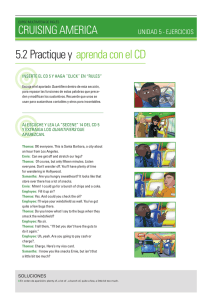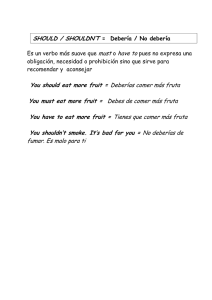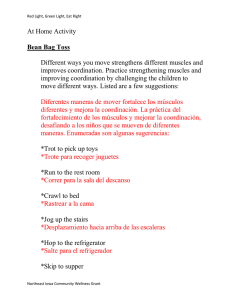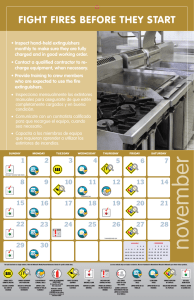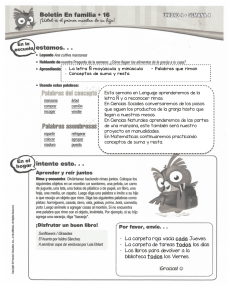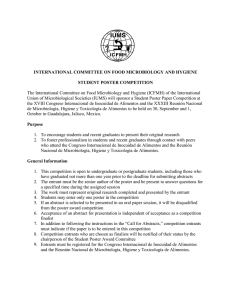Eat Healthy. Feel Better. - Inland Empire Health Plan
Anuncio
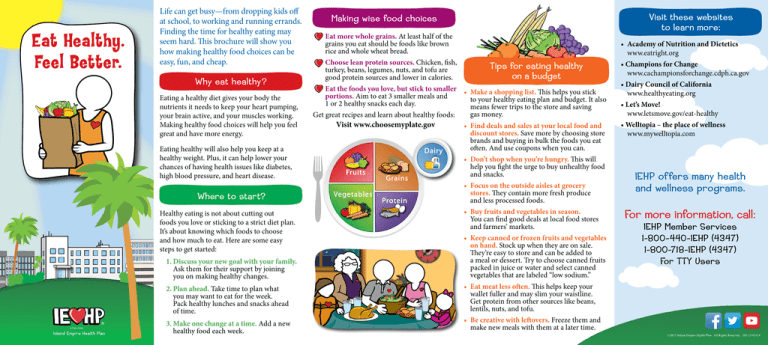
Eat Healthy. Feel Better. Life can get busy—from dropping kids off at school, to working and running errands. Finding the time for healthy eating may seem hard. This brochure will show you how making healthy food choices can be easy, fun, and cheap. Why eat healthy? Eating a healthy diet gives your body the nutrients it needs to keep your heart pumping, your brain active, and your muscles working. Making healthy food choices will help you feel great and have more energy. Eating healthy will also help you keep at a healthy weight. Plus, it can help lower your chances of having health issues like diabetes, high blood pressure, and heart disease. Where to start? Healthy eating is not about cutting out foods you love or sticking to a strict diet plan. It’s about knowing which foods to choose and how much to eat. Here are some easy steps to get started: 1.Discuss your new goal with your family. Ask them for their support by joining you on making healthy changes. 2.Plan ahead. Take time to plan what you may want to eat for the week. Pack healthy lunches and snacks ahead of time. 3.Make one change at a time. Add a new healthy food each week. Visit these websites to learn more: Making wise food choices Eat more whole grains. At least half of the grains you eat should be foods like brown rice and whole wheat bread. Choose lean protein sources. Chicken, fish, turkey, beans, legumes, nuts, and tofu are good protein sources and lower in calories. • Academy of Nutrition and Dietetics www.eatright.org Tips for eating healthy on a budget Eat the foods you love, but stick to smaller • Make a shopping list. This helps you stick portions. Aim to eat 3 smaller meals and to your healthy eating plan and budget. It also 1 or 2 healthy snacks each day. means fewer trips to the store and saving Get great recipes and learn about healthy foods: gas money. Visit www.choosemyplate.gov Dairy Fruits Vegetables Grains Protein • Find deals and sales at your local food and discount stores. Save more by choosing store brands and buying in bulk the foods you eat often. And use coupons when you can. • Don’t shop when you’re hungry. This will help you fight the urge to buy unhealthy food and snacks. • Focus on the outside aisles at grocery stores. They contain more fresh produce and less processed foods. • Buy fruits and vegetables in season. You can find good deals at local food stores and farmers’ markets. • Keep canned or frozen fruits and vegetables on hand. Stock up when they are on sale. They’re easy to store and can be added to a meal or dessert. Try to choose canned fruits packed in juice or water and select canned vegetables that are labeled “low sodium.” • Champions for Change www.cachampionsforchange.cdph.ca.gov • Dairy Council of California www.healthyeating.org • Let’s Move! www.letsmove.gov/eat-healthy • Welltopia – the place of wellness www.mywelltopia.com IEHP offers many health and wellness programs. For more information, call: IEHP Member Services 1-800-440-IEHP (4347) 1-800-718-IEHP (4347) For TTY Users • Eat meat less often. This helps keep your wallet fuller and may slim your waistline. Get protein from other sources like beans, lentils, nuts, and tofu. • Be creative with leftovers. Freeze them and make new meals with them at a later time. ©2015 Inland Empire Health Plan All Rights Reserved. HE-15-03119 Coma saludable. Siéntase mejor. Nuestro ritmo de vida puede ser ocupado: dejar a los niños en la escuela, trabajar y realizar tareas pedientes. Puede parecer difícil encontrar el tiempo para alimentarse de manera saludable. Este folleto le mostrará que elegir alimentos saludables puede ser fácil, divertido y económico. ¿Por qué es importante comer saludable? Seguir una dieta saludable permite otorgarle al cuerpo los nutrientes necesarios para que el corazón continúe bombeando, el cerebro se mantenga activo y los músculos sigan funcionando. Elegir alimentos saludables le ayudará a sentirse bien y tener mayor energía. Comer saludable también le ayudará a mantener un peso saludable. Además, puede ayudarle a reducir las probabilidades de tener problemas de salud, como diabetes, presión arterial alta y enfermedad cardíaca. ¿Cómo iniciar? Ingerir alimentos saludables no significa que debe dejar de comer lo que le gusta ni seguir una dieta estricta. Debe saber qué alimentos elegir y cuánto comer. Estos son algunos pasos sencillos para comenzar: 1.Hable de su nueva meta alimenticia con su familia. Pídales que le brinden su apoyo y que se unan a usted en los cambios saludables. 2.Planifique. Tómese un momento para planificar lo que podría desear comer el resto de la semana. Prepare almuerzos y bocadillos saludables con anticipación. 3.Realice un cambio a la vez. Agregue un nuevo alimento saludable cada semana. Elecciones inteligentes a la hora de comer Consuma más granos enteros. Al menos la mitad de los granos que consuma deben ser alimentos tales como arroz integral y pan de trigo integral. Elija fuentes de proteínas magras. El pollo, el pescado, el pavo, los frijoles, las legumbres, los frutos secos y el tofu son buenas fuentes de proteínas y tienen menos calorías. Coma alimentos que le agraden, pero en porciones más pequeñas. Intente comer 3 comidas con porciones más pequeñas y 1 ó 2 bocadillos saludables por día. Obtenga excelentes recetas y enterese cuáles son los alimentos más saludables: Visite www.choosemyplate.gov Lácteos Frutas Vegetales Granos Proteínas Consejos para comer saludable sin exceder el presupuesto • Haga la lista de las compras. Esto le ayudará a cumplir con su plan de alimentarse saludablemente y a mantenerse dentro de su presupuesto. Además, tendrá que ir menos veces a la tienda por lo que podrá ahorrar dinero en gasolina. • Busque ofertas y promociones en sus tiendas locales de alimentos y descuentos. Para ahorrar más, elija las marcas propias de las tiendas y compre al mayoreo los alimentos que consume con más frecuencia. Use los cupones siempre que le sea posible. • No compre alimentos cuando tenga hambre. Esto le permitirá combatir la ansiedad de comprar alimentos y bocadillos poco saludables. • Concéntrese en los pasillos laterales de las tiendas. Son los que tienen más productos frescos y menos alimentos procesados. • Compre frutas y vegetales de estación. Puede encontrar buenas ofertas en las tiendas y mercados locales donde venden frutas y vegetales. • Tenga a mano frutas y vegetales enlatados o congelados. Adquiéralos cuando estén de oferta. Son fáciles de guardar y pueden agregarse a su plan de alimentos o como postre. Trate de elegir frutas enlatadas/ envasadas en su propio jugo o en agua y seleccione vegetales enlatados que están etiquetados como "bajos en sodio". • No consuma carne en exceso. Esto le ayudará a ahorrar dinero y a mantener una buena figura. Ingiera frijoles, lentejas, frutos secos y tofu para consumir proteínas. • Sea creativo con los sobrantes de alimentos. Congélelos y úselos para preparar nuevas comidas en otro momento. Visite estos sitios web para obtener más información: • Academy of Nutrition and Dietetics www.eatright.org • Champions for Change www.cachampionsforchange.cdph.ca.gov • Dairy Council of California www.healthyeating.org • Let’s Move! www.letsmove.gov/eat-healthy • Welltopia – the place of wellness www.mywelltopia.com IEHP ofrece muchos programas relacionados con la salud y el bienestar. Para obtener más información, llame a: Servicios para Miembros de IEHP 1-800-440-IEHP (4347) 1-800-718-IEHP (4347) Para los usuarios de TTY

